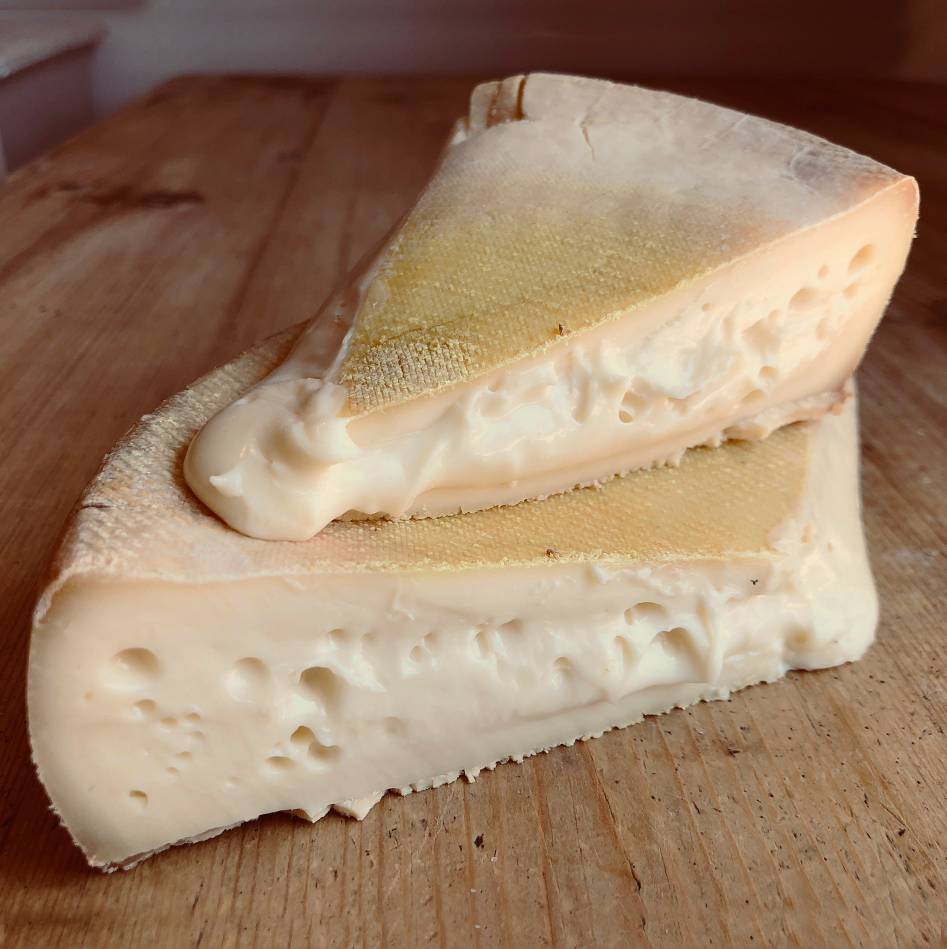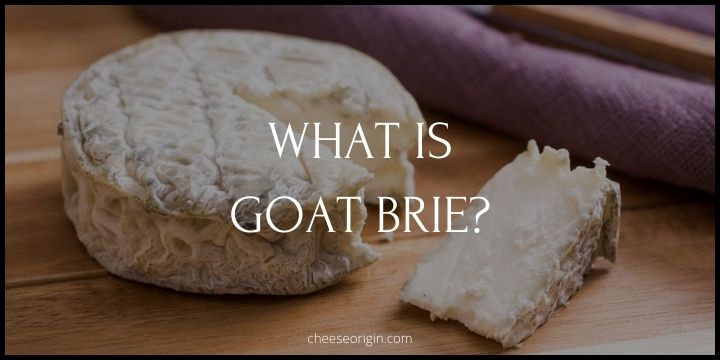What is Stinking Bishop? England’s Most Memorable Cheese

Unleash your senses and embark on an olfactory journey to the heart of England’s countryside with Stinking Bishop, the nation’s most memorable cheese. Its name alone is enough to spark intrigue, but it’s the distinctive aroma that truly sets this cheese apart.
Made from the creamy milk of Gloucester cattle and washed in perry made from the ‘Stinking Bishop’ pear variety, this cheese is a testament to British culinary tradition. But don’t let its pungent scent fool you; beneath the rind lies a soft, rich, and delectably complex flavor that perfectly balances the strong exterior.
Also read: Top 10 Most Popular England Cheeses
Quick Facts About Stinking Bishop
| Fact Category | Details |
|---|---|
| Origin | England, specifically Gloucestershire |
| Cheese Type | Soft, washed rind |
| Made from | Pasteurized Cow’s Milk |
| Texture | Creamy and Sticky |
| Color | Pale Yellow |
| Aroma | Strong and Pungent |
| Flavor | Mild with undertones of bacon and hay |
| Rind | Washed in perry (pear cider) |
| Aging period | 6 to 8 weeks |
| Famous For | One of Britain’s smelliest cheeses |
| Named After | A variety of pear used in the pear cider for washing the cheese |
| Pop Culture Fact | Featured in the Wallace and Gromit film, “The Curse of the Were-Rabbit” |
What is Stinking Bishop?

Stinking Bishop, a cheese as intriguing as its name, is a culinary experience that promises to awaken your senses. Originating from the heart of Gloucestershire in England, this unique cheese has been delighting (and surprising) cheese lovers since 1972. Crafted meticulously by Charles Martell and Son at Hunts Court Farm, Stinking Bishop is a testament to the art of traditional cheese making.
This full-fat cheese is made from pasteurized cow’s milk and vegetarian rennet, offering a creamy and delectable texture. But what truly sets it apart is its distinct aroma. This washed-rind cheese gets its infamous smell from soaking in perry, a type of pear cider, during its ripening process. The ripe, juicy pears used for the perry lend their name to the cheese itself – the Stinking Bishop pear.
Despite its bold smell, Stinking Bishop offers a surprisingly mild flavor with undertones of bacon and hay. Its brown/pink rind, a result of the perry wash, adds to its unique character. Available in whole 500g portions or smaller cut pieces, this cheese is a true conversation starter.
So, if you’re adventurous enough to overcome the initial smell, Stinking Bishop rewards you with a rich, flavorful experience. It’s more than just a cheese; it’s a journey through the traditions and craftsmanship of English cheese-making.
What Does Stinking Bishop Taste Like?
Stinking Bishop is a cheese that’s definitely known for its strong aroma, yet its taste often surprises those who dare to try it. Despite the intense smell, which some have compared to old socks or even the gunk under toenails, the flavor of Stinking Bishop is widely described as surprisingly mild.
This creamy cheese has been described as having a nutty and slightly sweet taste. The flavor profile lends itself to easy spreading on bread, making it an interesting addition to any charcuterie board. Some have even found the taste to be soft and creamy.
However, not everyone finds the taste of Stinking Bishop appealing. There are many people who describe the taste as acrid and spoiled. It’s worth noting that taste can be subjective, with personal preference playing a significant role.
The best way to eat Stinking Bishop is to ignore the smell and focus on the mild-flavored goodness of the cheese. The cheese gets its distinctive aroma from the Stinking Bishop pears used in the pear cider that the cheese is washed in during its ripening process.
While Stinking Bishop may not be for the faint-hearted, it certainly offers a unique gastronomic adventure for those willing to look past its infamous odor.
Stinking Bishop Tasting Notes

- Texture: Stinking Bishop is a soft and creamy cheese with a semi-soft texture. The consistency is spreadable, making it an excellent choice for bread or crackers.
- Appearance: It has a distinctive orange-pink rind, which is a result of being washed in perry (pear cider). The interior of the cheese is pale yellow.
- Aroma: Known for its potent smell, Stinking Bishop has an aroma that is often compared to a barnyard or old socks. This strong smell comes from the pear cider wash used during the ripening process.
- Taste: Despite its strong aroma, the taste of Stinking Bishop is surprisingly mild and nuanced. The flavor has been described as nutty and slightly sweet, with subtle undertones of bacon and hay.
- Aftertaste: The aftertaste of Stinking Bishop is lingering and savory, leaving a pleasant creaminess on the palate.
- Pairings: Stinking Bishop pairs well with fruit, especially pears and apples. It also complements robust red wines, dark beers, and ciders.
Why is Stinking Bishop so Famous?
It’s not just the smell that made Stinking Bishop famous. Its popularity soared after it was mentioned in the animated film “Wallace & Gromit: The Curse of the Were-Rabbit.” In the film, the cheese is used to revive Wallace from the dead, resulting in a surge in demand for Stinking Bishop. This pop-culture reference certainly contributed to its fame, turning it into a popular gag gift and a must-try for cheese lovers.
Also, the name itself – Stinking Bishop – is an attention-grabber. It’s named after the variety of pear used to make the perry for washing the cheese, but the unusual and somewhat irreverent name has undoubtedly added to its allure.
Despite its fame (or infamy), Stinking Bishop remains a delicacy among cheese connoisseurs. Beneath its intense aroma lies a relatively mild and creamy cheese that offers a unique gastronomic experience.
How to Eat Stinking Bishop?
- Serve at Room Temperature: For the best flavor, remove the Stinking Bishop from the refrigerator an hour before serving to allow it to reach room temperature.
- Crusty Bread or Crackers: The creamy texture of Stinking Bishop makes it perfect for spreading on crusty bread or crackers.
- With Fruit: Pair Stinking Bishop with fresh fruits like apples and pears to balance its rich, savory flavor.
- Cheese Board: Include Stinking Bishop in a cheese board. Its strong aroma and unique flavor make it a standout addition. Just remember to serve it last due to its potent smell.
- Wine or Cider Pairing: Stinking Bishop pairs well with robust red wines, dark beers, and ciders that can stand up to its strong flavor.
- Cooking: While it’s mostly enjoyed raw, Stinking Bishop can also be used in cooking. Try melting it into a sauce for a rich and flavorful twist.
Note: the key to enjoying Stinking Bishop is to embrace its strong aroma. Once you get past the smell, you’ll find a deliciously creamy cheese that’s full of flavor.
What is Stinking Bishop Made of?
| Ingredient/Process | Description |
|---|---|
| Milk | Stinking Bishop is made from pasteurized cow’s milk. The milk is sourced from Gloucester cattle, a traditional British breed known for their rich and creamy milk. |
| Starter Cultures | These are added to the milk to begin the fermentation process. They convert lactose (milk sugar) into lactic acid, which is essential in curdling the milk. |
| Rennet | Rennet, an enzyme, is added to further coagulate the milk, turning it from a liquid into a semi-solid state to form curds. |
| Cutting the Curd | The curd is cut into small pieces, a process that helps expel whey from the curd. This affects the final texture of the cheese. |
| Moulding and Pressing | The curds are placed into moulds and pressed to create the shape of the cheese and to remove any remaining whey. |
| Aging | The cheese is then aged for a specific period, during which it develops its unique flavor and aroma. Stinking Bishop is typically aged for 1-2 months. |
| Washing with Perry | The cheese is washed in perry – a type of cider made from fermented Stinking Bishop pears. This gives the cheese its distinctive smell and contributes to the development of its orange/pink rind. |
Where to Buy Stinking Bishop?
- Charles Martell & Sons
- St. Kilian’s Cheese Shop
- Cotswold Cheese Company
- The Cheese Society
- Birkdale Cheese Centre
- The Cheese Shed
- Murray’s Cheese
10 Best Stinking Bishop Substitutes
| Cheese | Description | Tasting Profile |
|---|---|---|
| Epoisses de Bourgogne | A French cheese washed in Marc de Bourgogne brandy. | Pungent, creamy, with a slightly sweet taste. |
| Munster | An Alsatian washed-rind cheese known for its strong smell. | Strong flavor, nutty and tangy taste. |
| Taleggio | An Italian washed-rind cheese that’s one of the oldest soft cheeses. | Mild, fruity, and slightly tangy. |
| Limburger | A Belgian-German cheese famous for its strong smell. | Creamy, earthy, and slightly bitter. |
| Pont l’Eveque | One of the oldest known cheeses from Normandy, France. | Rich, buttery, and slightly sweet. |
| Livarot | A French cheese often referred to as “The Colonel” due to its striped rind. | Strong, spicy, and full-flavored. |
| Langres | French cheese with a characteristic sunken top. | Soft, creamy, and a bit tangy. |
| Maroilles | A French cheese with a strong smell but mild taste. | Nutty, creamy, and slightly bitter. |
| Herve | A Belgian cheese with a strong smell, usually consumed with beer. | Spicy, salty, and slightly sour. |
| Reblochon | A French cheese with a nutty taste, used in tartiflette. | Nutty, creamy, and slightly fruity. |
What Pairs Well With Stinking Bishop?

Food that goes well with Stinking Bishop:
| Food Category | Specific Foods |
|---|---|
| Breads | Plain crackers, water biscuits, Digestive biscuits, crusty bread |
| Meats | Ham hock |
| Seafood | Poached mussels |
| Vegetables | Cornichon (French gherkin), cauliflower |
| Dishes | Gratin, particularly lamb gratin |
| Other Cheeses | Gruyère, Raclette |
| Recipes | Wild mushroom and Stinking Bishop recipe |
Beverage that goes well with Stinking Bishop:
| Beverage Category | Specific Beverages |
|---|---|
| Wine | Full-bodied red wines like Cabernet Sauvignon, Merlot, and Syrah. White wines like Sauvignon Blanc and Chardonnay. |
| Beer | Strong ales, stouts, porters and Belgian style beers. |
| Cider | Traditional English ciders, particularly those from the Gloucestershire area where Stinking Bishop is made. |
| Spirits | Whiskey, particularly peaty Scotch whiskies. Brandy, especially apple brandies. |
| Non-Alcoholic | Apple juice or cider, pear juice, robust black tea. |

Frequently Asked Questions
Also read:
- What is Good Thunder Cheese? A Taste of Minnesota’s Finest
- What is Rigotte de Condrieu? A Gem from the Lyonnaise Region
- What is Chabichou du Poitou? The Zesty, Grassy Cheese of France
- What is Fourme de Montbrison? The Gentle Blue From Southern France
- What is Sainte-Maure de Touraine? France’s Iconic Goat Cheese
- What is Pélardon? A Taste of the French Countryside in Every Bite
- What is Valençay? A Hidden Gem in the Loire Valley





